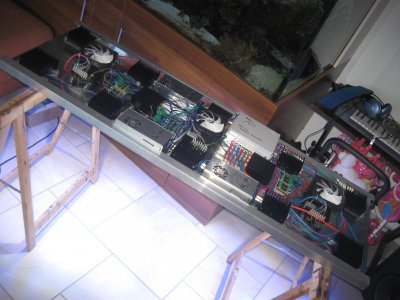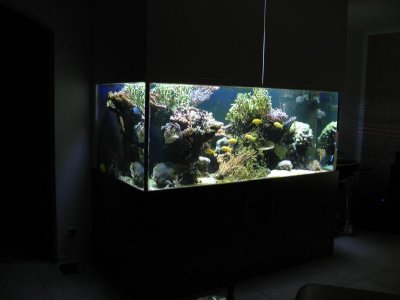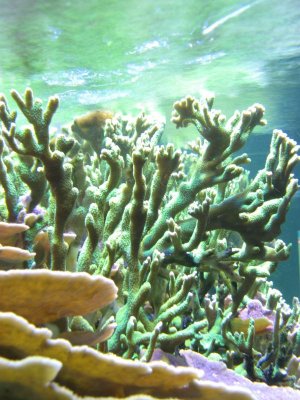hi,
first i want to introduce myself a little bit. My name is Michael and i'm in the hobby for about 16 years now. My tank is a decent 520g mixed reef tank. I'm a sps lover, but dont ask me about colors of my corals :spin3: I rather have a growing brownie than i dying pinkish purple yellow one.
I have to thank all contributors here on RC, fantastic! I'm silently reading here for years and learned a lot, thank you!
For now I want to introduce my new baby. A big LED fixture build on my own, completely. A big problem with commercial fixtures is often, that you have no chance to see them in action. You dont know if a fixture has enough power for your tank. And then there are all the LED 'haters' out there... But i wanted to switch from a MH, T5, Led combo (800 watts) to pure LED, nevertheless. Because i like to start demanding projects and i had absolutly no idea about electronics this was a nice project. So here are the facts and finally a video:
660 watts total (for the moment, upgrades are on the way...)
3 x 100 watts multichip led 12 K
18 x 20 watts multichip led 8 450 nm leds, 10 x 12K cool whites
real time weather simulation updated every 2 minutes, weather data taken from a weather station on Cayman Islands, or any other station i want.
5 different degrees of cloudiness
exact sunrise/sunset time
moonphase and moon travels over the lamp over night
softstart after sudden power off
remote controlling and monitoring via web application from everywhere on the planet where i have access to the internet.
What i like with this build is the possibilities you have with leds. Once I turned the fixture on, I never ever wanted to go back to the old 1980's style metal halides :beer:
here the video, please feel free to ask me, what you want to know about the build.
It was sometimes not easy but i'm quite happy with it. It is running for more than 3 months now and it runs absolutly rocksolid stable. My corals didnt noticed a big difference to the old lighting system. Maybe its because it is rarely running on full power due to the bad weather on the Caymans :smokin: It's often Partly Cloudy there. Some of them changed their color, but not that much. I'm planning to upgrade the fixture with some 10watts multichips for more ambient light, like t5s. I can document that if you like.
Here we go:
http://www.youtube.com/watch?v=P7i0LkUfnf4
with best regards,
first i want to introduce myself a little bit. My name is Michael and i'm in the hobby for about 16 years now. My tank is a decent 520g mixed reef tank. I'm a sps lover, but dont ask me about colors of my corals :spin3: I rather have a growing brownie than i dying pinkish purple yellow one.
I have to thank all contributors here on RC, fantastic! I'm silently reading here for years and learned a lot, thank you!
For now I want to introduce my new baby. A big LED fixture build on my own, completely. A big problem with commercial fixtures is often, that you have no chance to see them in action. You dont know if a fixture has enough power for your tank. And then there are all the LED 'haters' out there... But i wanted to switch from a MH, T5, Led combo (800 watts) to pure LED, nevertheless. Because i like to start demanding projects and i had absolutly no idea about electronics this was a nice project. So here are the facts and finally a video:
660 watts total (for the moment, upgrades are on the way...)
3 x 100 watts multichip led 12 K
18 x 20 watts multichip led 8 450 nm leds, 10 x 12K cool whites
real time weather simulation updated every 2 minutes, weather data taken from a weather station on Cayman Islands, or any other station i want.
5 different degrees of cloudiness
exact sunrise/sunset time
moonphase and moon travels over the lamp over night
softstart after sudden power off
remote controlling and monitoring via web application from everywhere on the planet where i have access to the internet.
What i like with this build is the possibilities you have with leds. Once I turned the fixture on, I never ever wanted to go back to the old 1980's style metal halides :beer:
here the video, please feel free to ask me, what you want to know about the build.
It was sometimes not easy but i'm quite happy with it. It is running for more than 3 months now and it runs absolutly rocksolid stable. My corals didnt noticed a big difference to the old lighting system. Maybe its because it is rarely running on full power due to the bad weather on the Caymans :smokin: It's often Partly Cloudy there. Some of them changed their color, but not that much. I'm planning to upgrade the fixture with some 10watts multichips for more ambient light, like t5s. I can document that if you like.
Here we go:
http://www.youtube.com/watch?v=P7i0LkUfnf4
with best regards,



